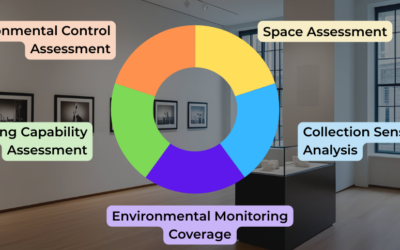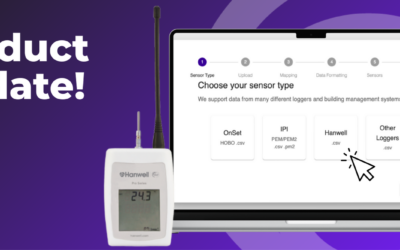Understanding the environment your collections are housed in is not a new concept. Curators and collectors have historically recognized that things like sun exposure, moisture levels, and heat can cause significant damage to items meant to be preserved for ages. For some time, however, the means by which collection spaces could be evaluated were limited.
Today’s technology, which allows those assessing their spaces to do so remotely, would only have been something that earlier curators dreamed of.
Tools to monitor, rather than just measure, are a fairly recent development. Technology like the mercury thermometer to measure temperature and the human hair hygrometer to measure relative humidity have existed for centuries. These provide snapshots of a single moment in time rather than a continuous log of changing conditions, which is most helpful for really understanding a collection environment.
Traditional hygrothermographs
Until about 30 years ago the only method for monitoring your collection data was a hygrothermograph. These were boxes about the size of a toaster. Inside were a set of pens connected to hairs.
As the temperature and humidity changed, the hairs would expand or contract, raising or lowering the pens. As the pens would change, they would leave a mark on a spinning piece of paper. This paper was the only record you had of your collection environment.
The information recorded was typically only temperature and/or RH. Any conversions or equations would need to be done manually, and if you did not change the paper your data was lost.
Digital data loggers
This all started to change in the early 1980’s with the introduction of the first digital data loggers. Now individuals could collect information about their spaces and implement some rudimentary software that could help determine things like dew point or potential for mold. However, this software was very limited in its abilities, and every brand of loggers used proprietary files. If you purchased one brand of loggers you were stuck using the software that came with them.
Software for cultural heritage collections
In 1997 the first software dedicated to cultural heritage collections was created, called Climate Notebook. This CD-ROM based software accepted some proprietary files or allowed them to be uploaded as .CSV files, allowing multiple brands of loggers to be used at once. It also was the first software to include preservation metrics of a collection space, such as metal corrosion, mechanical damage, or the preservation index.
Logging technology evolves
As the software would change the loggers would evolve as well. Around the early 2000’s newer, more ‘modern’ loggers would enter the market. These loggers would have digital screens to see the data for your space, alarms, and lights. A few loggers that came out around this time offered real time uploading. This would involve connecting a data logger to an ethernet port. This would upload data as long as the logger was plugged in.
As web-based information became more user-friendly, the Climate Notes software went from a CD-ROM format to a web-based model, giving users the same evaluations and metrics in an easier-to-access and track format.
Many data loggers mainly became smaller and more accurate but few offered the ability to remotely collect data.
Most data monitoring programs were reliant on staff members walking through the collection spaces routinely, to collect data and upload it to whatever software they were using to assess it. A task that, depending on the institution, could be time consuming.
Wireless data loggers
The most significant change to this field occurred around 2019.
Ironically, around the start of the COVID pandemic many data logger companies began to design data loggers that could collect data and remotely upload it using some form of wireless structure.
As more people found themselves working outside of the office, more companies began to offer wireless options.
BMS and universal file formats
Even the organizations that create the building management software (BMS) that controls the mechanical systems in your buildings began to allow the software greater ability to gather and export data similarly to a logger. These companies all also began to eliminate the use of the proprietary files for the universal .CSV. No longer were you reliant on one brand of data logger. Now most files can be uploaded to nearly any software or even Excel, if desired.
Most of these data loggers used Wi-Fi or Bluetooth wireless technology to upload the logged data to computer software for viewing and analysis. Challenges to wireless logging remained though, since Wi-Fi and Bluetooth can struggle to transmit over long distances and through dense building materials like concrete or steel.
Monitoring technology today
With all of this, newer software and hardware technology continues to emerge. This software aims to provide better evaluation and analysis of collection spaces. Technology has granted us the ability to be more mobile and more proactive when it comes to implementing our data monitoring program. Now in real-time one can collect data and analyze their spaces without having to walk to each logger.
Team leaders sitting in Washington, DC can evaluate the current conditions of collection spaces with staff across the country with neither person actively in the collection space.
Other forms of wireless technology like LoRaWAN (long range wide area network) make it possible to deploy loggers in remote sites or buildings with complicated architecture.
Keep checking your spaces
At the end of the day, whether you are using a hygrothermograph or a modern data logger, the data we collect paints important pictures about collection environments. But, let us just remember that even though we can now evaluate collection spaces without ever visiting them, no monitoring program is foolproof. Regardless of how technologically advanced your data monitoring system is, it is still important that that technology is combined with personal observation to ensure the most accurate representation of what is occurring in your collections space.
Join the Conserv community to hear more
Want to hear more from sustainable preservation specialist Christopher Cameron? You can read his AMA (Ask Me Anything) in the Conserv community. Join the free community for more preventive conservation discussions!
If you have any questions about environmental monitoring, integrated pest management, or just want to talk about preventative conservation, please reach out to us! Don’t forget to check out our blog or join our community of collections care professionals where you can discuss hot topics, connect with other conservators or even take a course to get familiar with the Conserv platform.





